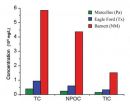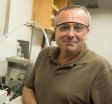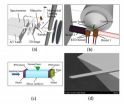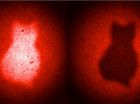(Press-News.org) HOUSTON – (Aug. 28, 2014) – Rice University scientists have produced a detailed analysis of water produced by hydraulic fracturing (aka fracking) of three gas reservoirs and suggested environmentally friendly remedies are needed to treat and reuse it.
More advanced recycling rather than disposal of "produced" water pumped back out of wells could calm fears of accidental spillage and save millions of gallons of fresh water a year, said Rice chemist Andrew Barron, who led the study that appeared this week in the Royal Society of Chemistry journal Environmental Science: Processes and Impacts.
The amount of water used by Texas drillers for fracking may only be 1.5 percent of that used by farming and municipalities, but it still amounts to as much as 5.6 million gallons a year for the Texas portion of the Haynesville formation and 2.8 million gallons for Eagle Ford. That, Barron said, can place a considerable burden on nearby communities.
Barron noted that shale gas wells, the focus of the new study, produce most of their water within the first few weeks of production. After that, a few barrels a day are commonly produced.
The project began with chemical analysis of fracking fluids pumped through gas-producing shale formations in Texas, Pennsylvania and New Mexico. Barron and the study's lead author, Rice alumnus Samuel Maguire-Boyle, found that shale oil and gas-produced water does not contain significant amounts of the polyaromatic hydrocarbons that could pose health hazards, but minute amounts of other chemical compounds led them to believe the industry would be wise to focus its efforts on developing nonchemical treatments for fracking and produced water.
Currently, fracturing fluid pumped into a well bore to loosen gas and oil from shale is either directed toward closed fluid-capture systems when it comes out or is sent back into the ground for storage. But neither strategy is an effective long-term solution, Barron said.
"Ultimately, it will be necessary to clean produced water for reuse in fracking," he said. "In addition, there is the potential to recover the fraction of hydrocarbon in the produced water."
Fracking fluid is 90 percent water, Barron said. Eight to nine percent of the fluid contains sand or ceramic proppant particles that wedge themselves into minute fractures in the rock, holding open paths for gas and oil to escape to the production well.
The remaining 1 or 2 percent, however, may contain salts, friction reducers, scale inhibitors, biocides, gelling agents, gel breakers and organic and inorganic acids. The organic molecules either occur naturally or are a residue from the added components.
The researchers found most of the salt, organic and other minerals that appear in produced water from shale gas reservoirs originate in the connate waters trapped in the dense rock over geologic time scales. These, they wrote, should be of little concern.
But they also found that produced water contained potentially toxic chlorocarbons and organobromides, probably formed from interactions between high levels of bacteria in the water and salts or chemical treatments used in fracking fluids.
Barron said industry sometimes uses chlorine dioxide or hypochlorite treatments to recycle produced water for reuse, but these treatments can actually enhance bacteria's ability to convert naturally occurring hydrocarbons to chlorocarbons and organobromides. The researchers suggested this transition could happen either downhole or in storage ponds where produced water is treated.
"We believe the industry needs to investigate alternative, nonchemical treatments to avoid the formation of compounds that don't occur in nature," Barron said.
Primarily, he said, the researchers want their analysis to anticipate future problems as industry develops processes to remove organic compounds from water bound for reuse.
The new paper, Barron said, should be of particular interest to international producers who are preparing to ramp up gas-recovery efforts in the United Kingdom, which recently announced plans to expand drilling, and other European countries.
"As the U.K. and other European countries are looking to start hydraulic fracturing, it is important that they adopt best practices at the start, as opposed to evolving over time, as it has occurred here in the United States," he said.
INFORMATION:
The Robert A. Welch Foundation and the Welsh Government Sêr Cymru Program funded the research. Barron is Rice's Charles W. Duncan Jr.–Welch Professor of Chemistry and a professor of materials science and nanoengineering.
Read the abstract at http://pubs.rsc.org/en/content/articlelanding/2014/em/c4em00376d#!divAbstract
This news release can be found online at http://news.rice.edu/2014/08/28/new-solutions-needed-to-recycle-fracking-water/
Follow Rice News and Media Relations via Twitter @RiceUNews
Related Materials:
Barron Research Group: http://barron.rice.edu/Barron.html
Images for download:
http://news.rice.edu/wp-content/uploads/2014/08/0902_FRACKING-1-WEB.jpg
Rice University researchers performed a detailed analysis of "produced" water from three underground shale gas formations subject to hydraulic fracturing. The chart shows the amounts of total carbon (TC), nonpurgeable organic carbon (NPOC) and total inorganic carbon (TIC) in the samples. (Credit: Barron Research Group/Rice University)
http://news.rice.edu/wp-content/uploads/2014/08/0902_fracking-2-web.jpg
Rice University chemist Andrew Barron led an analysis of water produced by hydraulic fracturing of three gas reservoirs and suggested environmentally friendly remedies are needed to treat and reuse it. (Credit: Jeff Fitlow/Rice University)
Located on a 300-acre forested campus in Houston, Rice University is consistently ranked among the nation's top 20 universities by U.S. News & World Report. Rice has highly respected schools of Architecture, Business, Continuing Studies, Engineering, Humanities, Music, Natural Sciences and Social Sciences and is home to the Baker Institute for Public Policy. With 3,920 undergraduates and 2,567 graduate students, Rice's undergraduate student-to-faculty ratio is just over 6-to-1. Its residential college system builds close-knit communities and lifelong friendships, just one reason why Rice is highly ranked for best quality of life by the Princeton Review and for best value among private universities by Kiplinger's Personal Finance. To read "What they're saying about Rice," go here.
David Ruth
713-348-6327
david@rice.edu
Mike Williams
713-348-6728
mikewilliams@rice.edu
New solutions needed to recycle fracking water
Rice University scientists seek long-term answers to stem increase of water use at wells
2014-08-28
ELSE PRESS RELEASES FROM THIS DATE:
Females ignored in basic medical research
2014-08-28
CHICAGO --- A new study from Northwestern Medicine® has found that surgical researchers rarely use female animals or female cells in their published studies -- despite a huge body of evidence showing that sex differences can play a crucial role in medical research.
Editors of the five major surgical journals reviewed in this study have responded to this finding and will now require authors to state the sex of animals and cells used in their studies. If they use only one sex in their studies, they will be asked to justify why.
"Women make up half the population, but ...
UTHealth researchers find up to 3,000 times the bacterial growth on hollow-head toothbrushes
2014-08-28
HOUSTON – (Aug. 28, 2014) — Solid-head power toothbrushes retain less bacteria compared to hollow-head toothbrushes, according to researchers at The University of Texas Health Science Center at Houston (UTHealth) School of Dentistry.
The results of the study are published in the August issue of the Journal of Dental Hygiene. Lead author and professor at the UTHealth School of Dentistry, Donna Warren Morris, R.D.H., M.Ed., notes that microbial counts were lower in the solid-head toothbrush group than in the two hollow-head toothbrush groups in 9 out of 10 comparisons.
"Toothbrushes ...
Together, humans and computers can figure out the plant world
2014-08-28
As technology advances, science has become increasingly about data—how to gather it, organize it, and analyze it. The creation of key databases to analyze and share data lies at the heart of bioinformatics, or the collection, classification, storage, and analysis of biochemical and biological information using computers and software. The tools and methods used in bioinformatics have been instrumental in the development of fields such as molecular genetics and genomics. But, in the plant sciences, bioinformatics and biometrics are employed in all fields—not just genomics—to ...
New analytical technology reveals 'nanomechanical' surface traits
2014-08-28
WEST LAFAYETTE, Ind. – A new research platform uses a laser to measure the "nanomechanical" properties of tiny structures undergoing stress and heating, an approach likely to yield insights to improve designs for microelectronics and batteries.
This new technique, called nanomechanical Raman spectroscopy, reveals information about how heating and the surface stress of microscale structures affect their mechanical properties. Researchers have discussed the merits of surface-stress influence on mechanical properties for decades. However, the nanomechanical Raman spectroscopy ...
Sensory-tested drug-delivery vehicle could limit spread of HIV, AIDS
2014-08-28
A unique method for delivering compounds that could positively impact the global battle against HIV and AIDS may be possible, thanks to researchers in Penn State's College of Agricultural Sciences.
A semi-soft vaginal suppository made from the seaweed-derived food ingredient carrageenan and loaded with the antiviral drug Tenofovir provides a woman-initiated, drug-delivery vehicle that can protect against the spread of sexually transmitted infections during unprotected heterosexual intercourse, the researchers said.
With more than 34 million people worldwide living with ...
The Lancet: Respiratory infection controls being used for ebola patients are unnecessary and may contribute to public panic
2014-08-28
Respiratory infection control measures – which have been adopted by most health agencies to deal with the Ebola epidemic in west Africa – are unnecessary, and may heighten panic and fear among the public, according to the authors of a new letter, published in The Lancet, and written by Professor Jose M. Martin-Moreno from the University of Valencia in Spain, and colleagues.
Ebola virus is primarily transmitted through contact with infected patients' blood, vomit, faeces and other secretions, both direct and indirect, from contaminated needles and other materials. This ...
Indoor mold poses health risk to asthma sufferers
2014-08-28
Damp and mould in homes could pose a significant health risk to people with asthma according to a new study published in the Journal of Allergy and Clinical Immunology.
By critically reviewing the findings from 17 studies in eight different countries, the research has found that the presence of several types of mould can lead to breathing problems in asthma sufferers, as well as increasing the likelihood of developing the condition.
The research has been conducted by a team at the University of Exeter Medical School and is the first time all of the information relating ...
Synthesis produces new antibiotic
2014-08-28
HOUSTON – (Aug. 28, 2014) – A fortuitous collaboration at Rice University has led to the total synthesis of a recently discovered natural antibiotic.
The laboratory recreation of a fungus-derived antibiotic, viridicatumtoxin B, may someday help bolster the fight against bacteria that evolve resistance to treatments in hospitals and clinics around the world.
As part of the process, Rice organic chemist K.C. Nicolaou and structural biologist Yousif Shamoo and their colleagues created and tested a number of variants of viridicatumtoxin B that could lead to the simplified ...
Inter-dependent networks stress test
2014-08-28
Energy production systems are good examples of complex systems. Their infrastructure equipment requires ancillary sub-systems structured like a network—including water for cooling, transport to supply fuel, and ICT systems for control and management. Every step in the network chain is interconnected with a wider network and they are all mutually dependent. A team of UK-based scientists has studied various aspects of inter-network dependencies, not previously explored. The findings have been published in EPJ B by Gaihua Fu from Newcastle University, UK, and colleagues. These ...
Quantum physics enables revolutionary imaging method
2014-08-28
This news release is available in German. Researchers from the Institute for Quantum Optics and Quantum Information (IQOQI), the Vienna Center for Quantum Science and Technology (VCQ), and the University of Vienna have developed a fundamentally new quantum imaging technique with strikingly counterintuitive features. For the first time, an image has been obtained without ever detecting the light that was used to illuminate the imaged object, while the light revealing the image never touches the imaged object.
In general, to obtain an image of an object one has to illuminate ...
LAST 30 PRESS RELEASES:
When is it time to jump? The boiling frog problem of AI use in physics education
Twitter data reveals partisan divide in understanding why pollen season's getting worse
AI is quick but risky for updating old software
Revolutionizing biosecurity: new multi-omics framework to transform invasive species management
From ancient herb to modern medicine: new review unveils the multi-targeted healing potential of Borago officinalis
Building a global scientific community: Biological Diversity Journal announces dual recruitment of Editorial Board and Youth Editorial Board members
Microbes that break down antibiotics help protect ecosystems under drug pollution
Smart biochar that remembers pollutants offers a new way to clean water and recycle biomass
Rice genes matter more than domestication in shaping plant microbiomes
Ticking time bomb: Some farmers report as many as 70 tick encounters over a 6-month period
Turning garden and crop waste into plastics
Scientists discover ‘platypus galaxies’ in the early universe
Seeing thyroid cancer in a new light: when AI meets label-free imaging in the operating room
Neutrophil-to-lymphocyte ratio may aid risk stratification in depressive disorder
2026 Seismological Society of America Annual Meeting
AI-powered ECG analysis offers promising path for early detection of chronic obstructive pulmonary disease, says Mount Sinai researchers
GIMM uncovers flaws in lab-grown heart cells and paves the way for improved treatments
Cracking the evolutionary code of sleep
Medications could help the aging brain cope with surgery, memory impairment
Back pain linked to worse sleep years later in men over 65, according to study
CDC urges ‘shared decision-making’ on some childhood vaccines; many unclear about what that means
New research finds that an ‘equal treatment’ approach to economic opportunity advertising can backfire
Researchers create shape-shifting, self-navigating microparticles
Science army mobilizes to map US soil microbiome
Researchers develop new tools to turn grain crops into biosensors
Do supervised consumption sites bring increased crime? Study suggests that’s a myth
New mass spec innovation could transform research
Maternal nativity, race, and ethnicity and infant mortality in the US
Migration-related trauma among asylum seekers exposed to the migrant protection protocols
Jupiter’s moon Europa has a seafloor that may be quiet and lifeless
[Press-News.org] New solutions needed to recycle fracking waterRice University scientists seek long-term answers to stem increase of water use at wells






